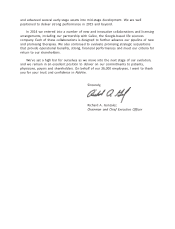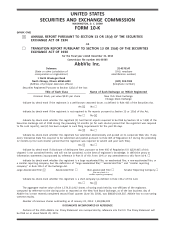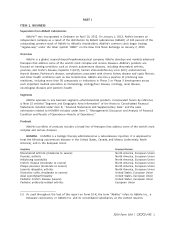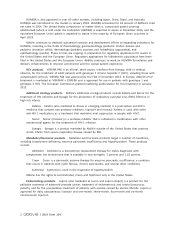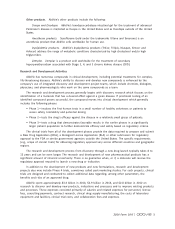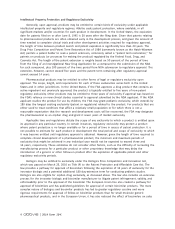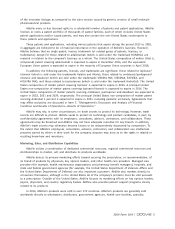AbbVie 2014 Annual Report Download - page 14
Download and view the complete annual report
Please find page 14 of the 2014 AbbVie annual report below. You can navigate through the pages in the report by either clicking on the pages listed below, or by using the keyword search tool below to find specific information within the annual report.
13NOV201221352027
clinically meaningful differences from the original product in terms of safety, purity, potency, and in vitro
characterization. The types of data that could ordinarily be required in an application to show similarity
may include analytical data and studies to demonstrate chemical similarity, animal studies (including toxicity
studies), and clinical studies. The law also requires that the biosimilar must be for an indication approved
for the original biologic and that the manufacturing facility meets the standards necessary to assure that
the biosimilar is safe, pure, and potent.
Furthermore, the new law provides that only a biosimilar product that is deemed to be
‘‘interchangeable’’ will be considered by the FDA to be substitutable for the original biologic product
without the intervention of the health care provider who prescribed the original biologic product. To prove
that a biosimilar product is interchangeable, the applicant must demonstrate that the product can be
expected to produce the same clinical results as the original biologic product in any given patient, and if
the product is administered more than once in a patient, that safety risks and potential for diminished
efficacy of alternating or switching between the use of the interchangeable biosimilar biologic product and
the original biologic product is no greater than the risk of using the original biologic product without
switching. The new law is only beginning to be interpreted and implemented by the FDA. As a result, its
ultimate impact, implementation, and meaning will likely be subject to substantial uncertainty for years to
come.
In the European Union, while a pathway for the approval of biosimilars has existed since 2005, the
products that have come to market to date have had a mixed impact on the market share of incumbent
products, with significant variation by product.
Other Competitive Products. Although a number of competitive biologic branded products have been
approved since HUMIRA was first introduced in 2003, most have gained only a modest share of the
worldwide market. AbbVie will continue to face competitive pressure from these biologics and from orally
administered products.
Regulation—Discovery and Clinical Development
United States. Securing approval to market a new pharmaceutical product in the United States
requires substantial effort and financial resources and takes several years to complete. The applicant must
complete preclinical tests, and obtain FDA approval before commencing clinical trials. Clinical trials are
intended to establish the safety and efficacy of the pharmaceutical product and typically are conducted in
three sequential phases, although the phases may overlap or be combined. If the required clinical testing is
successful, the results are submitted to the FDA in the form of an NDA or BLA requesting approval to
market the product for one or more indications. The FDA reviews an NDA or BLA to determine whether a
product is safe and effective for its intended use and whether its manufacturing is compliant with current
Good Manufacturing Practices (cGMP).
Even if an NDA or a BLA receives approval, the applicant must comply with post-approval
requirements. For example, holders of an approval must report adverse reactions, provide updated safety
and efficacy information, and comply with requirements concerning advertising and promotional labeling.
Also, quality control and manufacturing procedures must continue to conform to cGMP after approval. The
FDA periodically inspects manufacturing facilities to assess compliance with cGMP, which imposes extensive
procedural, substantive, and record keeping requirements. In addition, as a condition of approval, the FDA
may require post-marketing testing and surveillance to further assess and monitor the product’s safety or
efficacy after commercialization. Any post-approval regulatory obligations, and the cost of complying with
such obligations, could expand in the future.
Outside the United States. AbbVie is subject to similar regulations outside the United States. AbbVie
must obtain approval of a clinical trial application or product from the applicable regulatory authorities
before it can commence clinical trials or marketing of the product. The approval requirements and process
vary, and the time required to obtain approval may be longer or shorter than that required for FDA
82014 Form 10-K


